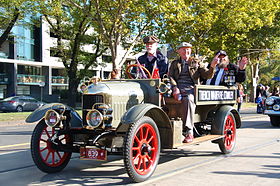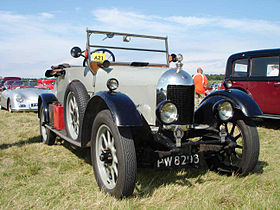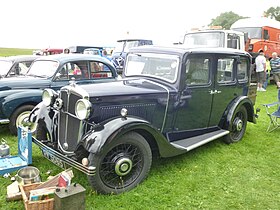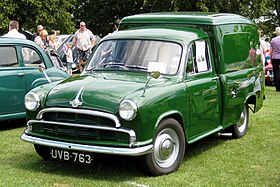Morris Cowley MCV
| Morris Cowley Continental Cowley |
|
|---|---|

Van (top removed) manufactured November 1916
|
|
| Overview | |
| Manufacturer | W R M Motors Limited |
| Production | 1915–1920 1450 approx |
| Assembly | Cowley, Oxford |
| Designer | W R Morris & Hans Landstad |
| Body and chassis | |
| Class | midsize car |
| Body style | two-seater, four-seater, coupé, cabriolet and delivery van |
| Related | Morris Oxford bullnose |
| Powertrain | |
| Engine | 1495 cc Continental Red Seal Type U |
| Transmission | dry 2-plate clutch, 3-speed gearbox (in cast aluminium housing), universal joint in a housing by the gearbox, propellor shaft enclosed by torque tube, rear axle: ¾ floating single piece banjo casing, spiral bevel final drive |
| Dimensions | |
| Wheelbase |
8' 6" 102 in (2,590.8 mm) |
| Chronology | |
| Successor | Morris Cowley (1919 model) |
| Continental Red Seal Type U 1495 / 1557 |
|
|---|---|
| Overview | |
| Manufacturer | Continental Motor Manufacturing Company Muskegon and Detroit USA |
| Production | 1915 |
| Combustion chamber | |
| Configuration | straight-4 cast en bloc |
| Displacement |
nominal 1.495 L (91.2 cu in) |
| Cylinder bore |
nominal 69 mm (2.7 in) |
| Piston stroke |
nominal 100 mm (3.9 in) |
| Cylinder block alloy | cast-iron 3-bearing crankshaft pistons: cast-iron crankshaft: Desaxé, white metal bearings in phosphor bronze shells, sump cast aluminium |
| Cylinder head alloy | cast-iron detachable; fitted with priming taps; plain copper gasket |
| Valvetrain | side valve L-head, helical timing gears |
| Combustion | |
| Fuel system |
carburettor: Zenith gravity fed horizontal
|
| Fuel type | petrol |
| Oil system | main bearings: pressure lubricated by plunger pump, pressure test by special tap. big ends: splash. if not first, one of the first British cars with a dipstick |
| Cooling system | water thermosyphon, fan assisted radiator by Doherty Motor Components or Randle, both of Coventry |
| Output | |
| Power output |
not published |
| Chronology | |
| Successor | Hotchkiss |
| Hotchkiss later Morris 1548 |
|
|---|---|
| Overview | |
| Manufacturer | Hotchkiss & Cie. Gosford Street Coventry until May 1923, works thereafter under the ownership of Morris Engines Limited |
| Production | 1919 to 1926 |
| Combustion chamber | |
| Configuration | straight-4 cast en bloc with upper crankcase |
| Displacement | 1.548 L (94.5 cu in) |
| Cylinder bore | 69.5 mm (2.74 in) |
| Piston stroke | 102 mm (4.0 in) |
| Cylinder block alloy | cast-iron 3-bearing crankshaft pistons: cast-iron crankshaft: steel stamping, bronze backed white metal bearings, sump cast aluminium |
| Cylinder head alloy | cast-iron detachable copper asbestos sandwich gasket |
| Valvetrain | side valve L-head, helical timing gears, camshaft in two plain bearings operating valves by mushroom head tappets, single valve springs |
| Combustion | |
| Fuel system |
carburettor:
exhaust: 3-port
magneto: helical bevel drive |
| Fuel type | petrol |
| Oil system | main bearings and camshaft gear: pressure lubricated by plunger pump from camshaft big ends: splash |
| Cooling system | water thermosyphon, fan assisted radiator 1919 by Randle, thereafter by Osberton |
| Output | |
| Power output | not published RAC (tax) rating 11.9hp |
| Chronology | |
| Predecessor | Continental Red Seal |
| Morris 1802 |
|
|---|---|
| Overview | |
| Manufacturer | Morris Engines Limited Gosford Street Coventry |
| Production | 1923 to 1926 |
| Combustion chamber | |
| Configuration | straight-4 cast en bloc with upper crankcase |
| Displacement | 1.802 L (110.0 cu in) |
| Cylinder bore | 75 mm (3.0 in) |
| Piston stroke | 102 mm (4.0 in) |
| Cylinder block alloy | cast-iron 3-bearing crankshaft pistons: cast-iron crankshaft: steel stamping, bronze backed white metal bearings, sump cast aluminium |
| Cylinder head alloy | cast-iron detachable copper asbestos sandwich gasket |
| Valvetrain | side valve L-head, helical timing gears, camshaft in two plain bearings operating valves by mushroom head tappets, single valve springs |
| Combustion | |
| Fuel system |
carburettor: Smith (various)
|
| Fuel type | petrol |
| Oil system | main bearings and camshaft gear: pressure lubricated by plunger pump from camshaft big ends: splash |
| Cooling system | water thermosyphon, fan assisted radiator: Osberton |
| Output | |
| Power output | not published RAC (tax) rating 13.9hp |
| Chronology | |
| Predecessor | Morris 1548 cc |
| Morris Cowley | |
|---|---|

Two-seater first registered 30 June 1926
|
|
| Overview | |
| Manufacturer | Morris |
| Production | 1919–1926 150,000 made (including Oxford model) |
| Body and chassis | |
| Related | Morris Oxford bullnose |
| Powertrain | |
| Engine | 1548 and 1802 cc side-valve Straight-4 |
| Dimensions | |
| Wheelbase | 102 inches (2.59 m) 108 inches (2.74 m) from 1925 |
| Chronology | |
| Predecessor | Morris Cowley 1915 |
| Successor | Morris Cowley (1926–1931) |
| Morris Cowley | |
|---|---|

Two-seater first registered 2 May 1927
|
|
| Overview | |
| Manufacturer | Morris |
| Production | 1926–1931 201,692 made. |
| Body and chassis | |
| Body style | 2 and 4 seat tourer, coupé, 4-door saloon, folding head saloon (1930). |
| Related | Morris Oxford flatnose |
| Powertrain | |
| Engine | 1548 cc side-valve Straight-4 |
| Dimensions | |
| Wheelbase | 102 inches (2560 mm) |
| Length | 150 inches (3810 mm) |
| Width | 58.5 inches (1486 mm) |
| Chronology | |
| Predecessor | Morris Cowley (1919) |
| Successor | Morris Cowley (1931) |
| Morris Cowley | |
|---|---|

1933-34 model Four-door six-light 11.9 hp saloon
first registered 16 May 1934 |
|
| Overview | |
| Manufacturer | Morris |
| Production | 1932–1935 39,074 made. |
| Body and chassis | |
| Body style |
|
| Related | Morris Oxford and Morris Twelve |
| Powertrain | |
| Engine | 11.9 = 1548 cc or 14/32 = 1802 cc side-valve Straight-4 |
| Dimensions | |
| Wheelbase | 105 inches (2667 mm) |
| Length | 155 inches (3937 mm) |
| Width | 60.5 inches (1537 mm) |
| Chronology | |
| Predecessor | Morris Cowley (1926–1931) |
| Successor | Morris Twelve |
| Morris Cowley Six | |
|---|---|

Morris Cowley Six six-light saloon 1934
|
|
| Overview | |
| Manufacturer | Morris |
| Production | 1934–1935 15,470 made. |
| Body and chassis | |
| Body style | 4-door saloon, 2 door coupé. |
| Related | Morris Oxford Six |
| Powertrain | |
| Engine | 63.5 x 102mm (same as Ten-Four) 1938 cc side-valve Straight-6 15 hp 36 bhp at 3,400 rpm |
| Dimensions | |
| Wheelbase | 106 inches (2692mm) |
| Width | 65.5 inches (1664 mm) |
| Chronology | |
| Predecessor | Morris Major |
| Successor | Morris Fifteen-Six |
| Morris Cowley MCV | |
|---|---|
 |
|
| Overview | |
| Manufacturer | Morris/BMC |
| Production | 1950 - 1956 |
| Body and chassis | |
| Body style | 2-door van 2-door pick-up 2-door chassis-cab |
| Related | Morris Oxford |
| Chronology | |
| Successor | Morris ½-ton Series III |
| Morris ½-ton series III | |
|---|---|

½-ton series III Van 1959
|
|
| Overview | |
| Manufacturer | British Motor Corporation |
| Production | 1956–62 |
| Assembly | United Kingdom |
| Body and chassis | |
| Body style | 2-door van 2-door pick-up 2-door chassis-cab |
| Layout | FR layout |
| Chronology | |
| Predecessor | Morris Cowley MCV |
Morris Cowley was a name given to various cars produced by Morris from 1915 to 1958.
8' 6" 102 in (2,590.8 mm)
The Continental Cowley, shown to the press in April 1915, was a larger engined (1495 cc against 1018 cc), longer, wider and better equipped version of the first Morris Oxford with the same "Bullnose" radiator; in addition it could carry a four-passenger body. To reduce the price many components were bought from United States suppliers. The 1495 cc, side valve, four cylinder engine was made by Continental Motor Manufacturing Company of Detroit, and the clutch and three speed gearbox by Detroit Gear & Machine Co. Back axle, front axle and steering gear also came from the USA. Supply of these components was badly affected by World War I. The suspension used semi elliptic leaf springs at the front and three quarter elliptics at the rear.
The central position of the handbrake and ball change gear lever revealed the gearbox's US origin. It also made for easy entry through the driver's door and no cold steel up a driver's leg. The petrol tank was in the scuttle and its filler was above the gear lever in the centre of the dashboard.
The US-made back axle was the first helically cut drive in a quantity produced British car.
Electric lighting was standard. It was the first Morris car to be sold like that. The 6-volt Lucas lamps were a set of five, powered by a belt-driven dynamo fixed to the engine by its cylinder head studs. The cost of these few electrical components was equivalent to 59% of the cost of the imported engine. The delivery van body was not provided with electric lighting.
There was no austerity for the Cowley though it was at first slightly cheaper than the Oxford. There was diamond patterned buttoned upholstery in real leather set off by mahogany cappings, and a proper door for the driver. The mudguards were black and the standard body colour was a chocolate brown. The Cowley did not become a stripped down Oxford until 1919.
Although first shown to the press in April 1915 the new car was not generally available until late summer that year just when the government suddenly imposed the McKenna duties. A tax of 33% was imposed on imported "luxury" goods but demand for the Cowleys seemed to ignore the price rises.
source
The last Continental Cowley was assembled in 1920 finishing the stock of original engines. Three thousand engines were despatched to Morris but more than half were lost by enemy action while crossing the Atlantic leaving around 1,500 sets of certain chassis components unsold. More recent research suggests that there may have been only one shipment of about 150 lost through enemy action and orders for more shipments were cancelled.
...
Wikipedia
